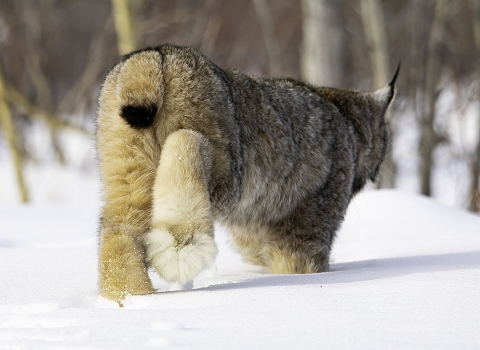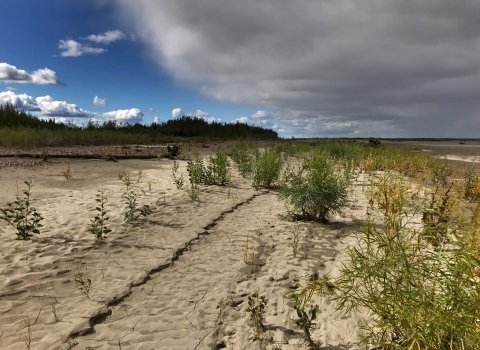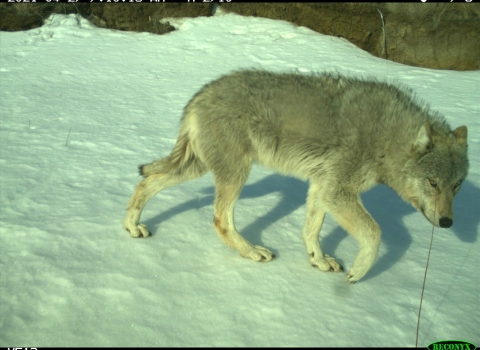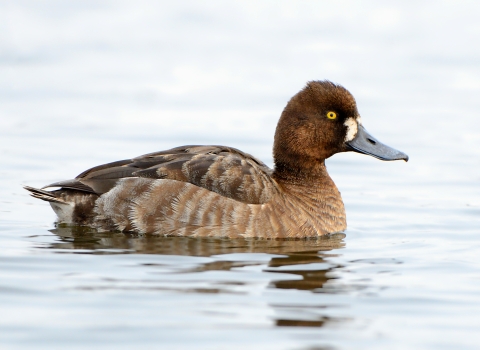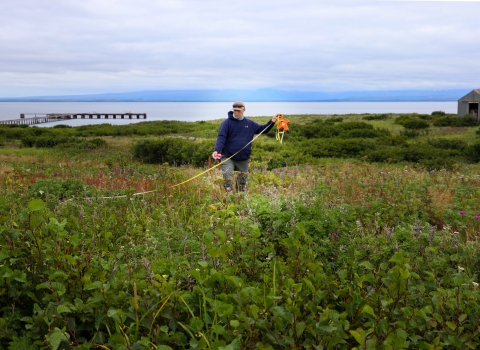Projects and Research
We've got a number of ongoing projects and are noticing changes to the refuge including the following:
- Warmer temperatures, especially in winter
- Thawing permafrost and changing plants
- Lake drying and changing water conditions
- More frequent large wildfires
- Arrival of more southern wildlife species
The Yukon Flats is one of the most fire-prone regions of Alaska and is subject to repetitive but irregular, long-term cycles of burning and regeneration. The fire season in most years extends from late April through July.
Fire on the Yukon Flats is essential to maintaining healthy plant and wildlife communities. The Yukon Flats boreal forest is an excellent example of a fire-...
The Northwest Boreal Forest Lynx Project is a collaborative effort between the U.S. Fish and Wildlife Service, the University of Alaska Fairbanks, and the National Park Service to study movement patterns, dispersal behavior, and survival of lynx in relation to snowshoe hare abundance.
Canada lynx populations depend on snowshoe hare as their primary prey. Hare populations are...
This project enumerates Yukon River fall Chum Salmon in the upper portion of the Yukon River drainage. The Teedriinjik River (formerly designated as the Chandalar but recently reverted back to its Gwich'in names) is a major river system in Interior Alaska. Its salmon stocks support vital subsistence and commercial fisheries in the Yukon River drainage, and are an important...
There are no roads into Yukon Flats National Wildlife Refuge. The primary access is by boat and aircraft from the hub community of Fairbanks which is a known source of terrestrial and aquatic invasive plant populations. Invasive species can come into the refuge on goods, equipment, nursery plants, and they can hitchhike on boats and floatplanes. Invasive species can also be spread...
A network of trail cameras capture life on the refuge year-round. This project began in 2016, starting with 16 cameras deployed in the fall and kept active all winter. Since then, the number of cameras has expanded to 34. Through 2020, 467,739 photos were recorded. Of those, 12,211 contained a lynx and 49,049 contained a photo of a terrestrial mammal or bird.
This effort has...
We periodically place federal metal leg bands on ducks just prior to hunting season. This information is used to inform harvest regulations. Ducks are captured by baiting sites with cracked corn and placing traps. The species, age, and sex of captured ducks is recorded prior to banding and release. In 2021, 215 Northern Pintail, 211 American Green-winged Teal, 38 Mallard, and 6 American Wigeon...
Population status of moose is important for managers of Yukon Flats National Wildlife Refuge because this species is an important source of food for people, and densities on the Refuge are among the lowest in North America. The most recent survey was completed in November/December 2018. This was the first fall survey since 2015. Moose were counted in 97 of 421, 5.3 mi2 units, of which 63...
Each year we count duck broods to index production. This survey targets Lesser Scaup and counts begin around 21 July. Up to 43 wetlands are sampled, spread among 2-4 wetland complexes. Counts are conducted on foot or from small inflatable boats. Relative to the long-term pattern, we look for decreases, no change, increases, or big increases in production across index waterbodies.
As part of the National Wetlands Inventory, we are mapping and digitizing high priority wetlands in Alaska’s 16 National Wildlife Refuges.
The U.S. Fish and Wildlife Service is the principal federal agency tasked with providing public information on the status and trends of our Nation's wetlands. Our National Wetlands Inventory provides detailed information...
Invasive Species Program staff collaborate with Alaska's National Wildlife Refuge, the State of Alaska and other partners to protect Alaska's lands and waters by working to detect invasive species infestations while they’re still relatively small and have the highest chance of being successfully eradicated. We survey terrestrial, freshwater, and marine environments for invasive plants and...

